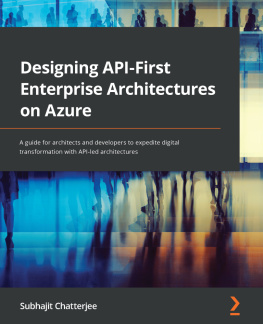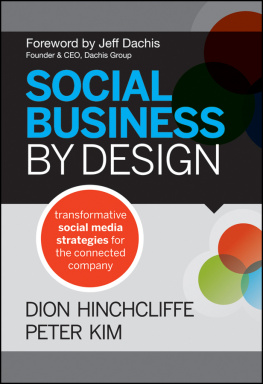Web 2.0 Architectures
James Governor
Dion Hinchcliffe
Duane Nickull
Copyright 2009 James Governor, Dion Hinchcliffe, and Duane Nickull, Duane Nickull, James Governor, and Dion Hinchcliffe
OReilly books may be purchased for educational, business, or sales promotional use. Online editions are also available for most titles (.
Nutshell Handbook, the Nutshell Handbook logo, and the OReilly logo are registered trademarks of OReilly Media, Inc. Web 2.0 Architectures , the image of a banded linsang, and related trade dress are trademarks of OReilly Media, Inc.
Many of the designations used by manufacturers and sellers to distinguish their products are claimed as trademarks. Where those designations appear in this book, and OReilly Media, Inc. was aware of a trademark claim, the designations have been printed in caps or initial caps.
While every precaution has been taken in the preparation of this book, the publisher and authors assume no responsibility for errors or omissions, or for damages resulting from the use of the information contained herein.
This book uses RepKover, a durable and flexible lay-flat binding.

Adobe Dev Library
If youre in the technology industry or your business uses the Internet, chances are youve heard of Web 2.0. But what exactly is it?
Some people think of Web 2.0 as the assimilation of human participation into web architecture, while some define it as a natural progression of the Internet. Others claim that Web 2.0 is actually what the first generation of the Internet strived to be. There are many different definitions and examples. While researching this book, we encountered people who vehemently denied the existence of Web 2.0, and others who spoke of it as though it were as tangible as the very earth on which they stood.
Controversy aside, its hard not to recognize that the Internet has evolved dramatically, creating a genuine sense of excitement about whats happening in cyberspace. This book delves into the sources of that excitement, examining the design patterns and models behind things deemed Web 2.0 and exploring how the Internet grew from its humble origins to its current state. During this journey, you will take a dive into the way architects think, learn how to separate fact from hype and pragmatic views of technology from empty buzzwords, and seek truth.
Why Web 2.0 Matters
Web 2.0 generally refers to a set of social, architectural, and design patterns resulting in the mass migration of business to the Internet as a platform. These patterns focus on the interaction models between communities, people, computers, and software. Human interactions are an important aspect of software architecture and, even more specifically, of the set of websites and web-based applications built around a core set of design patterns that blend the human experience with technology.
This book captures what Web 2.0 is by analyzing major changes in web resources uncontentiously deemed to be Web 2.0 so that entrepreneurs, architects, and developers worldwide can reapply the knowledge to new business models. The format for that knowledge is expressed within this book as a set of patterns. Every website that implements Web 2.0 yields important clues regarding its core design patterns, models, and solutions that we can repurpose or leverage to solve other problems. This book lays out those patterns in such a way that readers can improve on and implement them over multiple technologies, families, and contexts.
This book often refers to the new Internet, a term used to include Web 2.0 design patterns and associated technical evolutions, such as the rapid adoption of broadband. The new Internet is not being built as a product of speed increases alone, though. Easy-to-use developer technologies coupled with innovative design patterns from smart entrepreneurs are the primary drivers for new, innovative Internet applications. Continued performance improvements in technology, along with designers building visually compelling user experiences connected to sophisticated services, have made new patterns of interaction possible.
One of these, sometimes mistaken for Web 2.0 itself, is a development trend). New sets of vendor tools and technologies, along with better application architectures, are putting RIA development capabilities at the fingertips of hobbyists. However, from an architects perspective, how do you quantify richness? Is there a list of visual elements that are required, perhaps along with some optional elements? For an application to be rich, it must surely incorporate some functionality that defines it as being different from a non-RIA. But like beauty, the richness of an application lies in the eyes of the beholder. As with many other Web 2.0 concepts, the definition can be captured at best as a design pattern, with notes to aid implementers.
Beyond the development tools and techniques they use, much of the success of companies deemed to be Web 2.0 is a by-product of a pattern of viral marketing, a scenario in which a new site is promoted far faster via word of mouth than any advertising executive could feasibly achieve via other channels. This phenomenon makes Web 2.0 a hot topic among venture capitalists. Entrepreneurs are creating Web 2.0 sites and applications that are so compelling that the users themselves do the marketing, enabling the little guys to enter into head-to-head competition on an even footing with large multinational corporations with huge advertising budgets. Enthusiastic users of a Web 2.0 site can bury a large corporations expensive advertising efforts within months. A case in point is MySpace.com, which became the top web destination in early 2007 based largely on viral marketing and content created by its own users. Other companies, such as Twitter, Facebook, YouTube, and Flickr, share this pattern.
On these companies sites, users both provide and consume the bulk of the data. The users are an integral part of the sites overall conceptual architecture. These new Internet sites have changed in terms of how people experience them, too. Analysts predict that the bulk of first-time Internet users in the next decade might use wireless connections as their first means of connecting to the Internet.[] These are only a few examples of what this rich interconnected tool makes possible.
Web 2.0 represents more than just a change in Internet technology. It is a global change in how we engage with one another. Customer brand loyalty is at an all-time low. Competition is a mere click away for most companies. With the realization of social change comes a desire on the part of large enterprises to learn about the mechanisms behind Web 2.0. As enterprises race to gain a competitive edge over their global competitors, theyre realizing that Web 2.0 design patterns can be a critical ingredient in their overall success or failure.
Streaming high-definition television (HDTV)[] it should become clear that the battle for the media is in a state of flux.
Its not just a multimedia issue, though. A key trend in Web 2.0 is the inclusion of the user as a core part of any model. Most Web 2.0 examples have breached the purely technical realm and include users as an integral part of their workflow. Online applications are more than mere software; they represent a process of engagement with users. Users provide key functionality and content in most Web 2.0 applications, helping to build a web of participation and collaboration. These design patterns drive young startups, while incumbent enterprises scramble to adapt to the threat posed to them by people who have built something better to engage the user.







